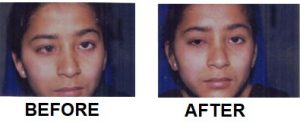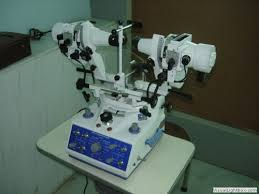What is amblyopia(Lazy Eye)?
Amblyopia (lazy eye) is poor vision in an eye that did not develop normally during childhood. It commonly affects one eye but may also involve both eyes. It is generally caused by lack of use of one eye, when brain ‘favors’ one eye over the other.
What causes amblyopia?
The visual system of the child is not fully developed at birth. The visual brain cells of a child are developing during their first decade of life. Any insult to the child’s vision during this time period can lead to amblyopia
Following are the common causes of amblyopia:
- Squint: This is the commonest cause of amblyopia. The brain to avoid double vision ignores the image from the deviating eye. This leads to poor visual development of the deviating eye and hence amblyopia.
- Unequal refractive error (anisometropia): In this condition, the two eyes have different refractive errors. Because the brain cannot “balance” this difference, it picks the eye that is “easier” to use and develops a preference for this eye only. The eye with greater refractive error is suppressed and thus gets amblyopic. An early treatment by giving the right glasses for correction can prevent and correct this problem.
- Stimulus deprivation: Any form of stimulus derivation to either one or both eyes in early childhood may lead to a severe form of amblyopia. These causes for stimulus deprivation may be ptosis, cataract, glaucoma, patching or any other obstacle that blocks the vision in the eye.
How can we detect if the child has amblyopia?
 Detecting amblyopia in child is difficult, as the child may not be aware of having one strong eye and one weak eye. If the child has a squint or some other abnormality, the parents may notice that something is wrong. The vision of the child can be tested by the ophthalmologist by special tests. Poor vision in an eye may point towards a possibility of amblyopia. Remember, poor vision in an eye does not always mean amblyopia. It is important to rule out other causes of poor vision in child
Detecting amblyopia in child is difficult, as the child may not be aware of having one strong eye and one weak eye. If the child has a squint or some other abnormality, the parents may notice that something is wrong. The vision of the child can be tested by the ophthalmologist by special tests. Poor vision in an eye may point towards a possibility of amblyopia. Remember, poor vision in an eye does not always mean amblyopia. It is important to rule out other causes of poor vision in child
Is it treatable?
Yes. In most of the cases the amblyopia is treatable. The treatment involves ‘forcing’ the brain to use the weaker eye and thus stimulating its visual development. This is done by patching the better eye. The schedule of patching is decided by the ophthalmologist depending upon the degree of amblyopia and the age of child.
When should it be treated?
As soon as possible. The earlier the amblyopia is detected and the treatment started, the better are the results. The aim is to stimulate the brain to use the suppressed eye before permanent change has occurred, so that it gets a chance of normal development. Generally speaking, an amblyopia that is not treated by 10 years of age has a poor chance of recovering the vision.
Why is it important to treat amblyopia?
If an amblyopic eye is not treated by 10 years of age, the amblyopic eye may permanently stay weak. This has many disadvantages like:
-
-
-
- Both eyes cannot be used simultaneously and hence depth perception (three-dimensional vision) is not present. Many occupations are not open for people who have good vision in one eye only.
- It is important to give best possible vision to the amblyopic eye even if the other eye is seeing well. The importance of this becomes obvious, in case the person loses the other (better) eye, sometime later due to some injury or disease.
-
-
What are the factors that determine the success of treatment?
The success of amblyopia treatment largely depends upon the motivation of parents and the cooperation of the child. Patching of the better eye, especially when the amblyopic eye has very poor vision is not tolerated well by the child. The parents have to understand the importance of this treatment and should explain the same to the child to ensure better cooperation.

The other factors that determine the success of treatment are:
-
-
-
- The severity (depth) of amblyopia
- The age at which the treatment is started: The earlier the treatment is started, the better are the results
- Any other complicating factor in the eye preventing sufficient gain of vision, e.g., glaucoma, cataract, retinal or optic nerve disorders
-
-
My child has squint and amblyopia. Which should be treated first?
Amblyopia has to be treated first in all these cases. Once the amblyopia has been taken care of, the surgery may be done for squint correction.
